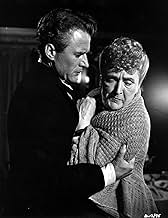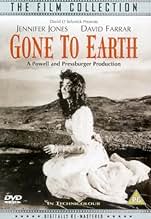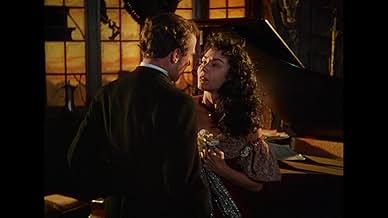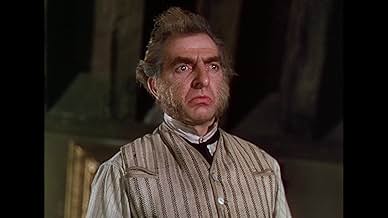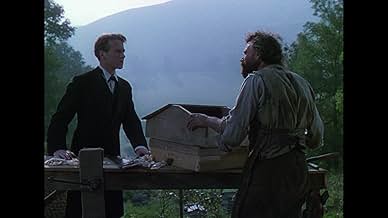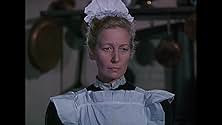IMDb-BEWERTUNG
6,9/10
1656
IHRE BEWERTUNG
Füge eine Handlung in deiner Sprache hinzuA beautiful, superstitious, animal-loving Gypsy is hotly desired by a fox-hunting squire even after she marries a clergyman.A beautiful, superstitious, animal-loving Gypsy is hotly desired by a fox-hunting squire even after she marries a clergyman.A beautiful, superstitious, animal-loving Gypsy is hotly desired by a fox-hunting squire even after she marries a clergyman.
- Regie
- Drehbuch
- Hauptbesetzung
- Auszeichnungen
- 3 Gewinne & 1 Nominierung insgesamt
Arthur Mainzer
- Chapel elder
- (as Arthur Reynolds)
Empfohlene Bewertungen
about a wild child in rural England in 1897. Half gypsy, the girl (Jennifer Jones) worships nature, animals, superstitions, etc. but has an odd, eerie "one-ness" with the world. However, when sex enters the picture, her world spins out of control. A timid parson (Cyril Cusack) marries her but chains her to a sexless marriage. She runs off with a lusty squire (David Farrar) and lives in his ramshackle estate. Truly offbeat story, totally gorgeous cinematography by Christopher Challes, and good performances by all make this watchable. Sadly, the US version had 30 minutes lopped off and shows it. The Brit version, titled "Come to Earth" is supposedly superior. Symbolism is worthy of any good Lawrencian story where love is in opposition to nature and where sex can only survive outside marriage. Jones looks great. Oddly forgotten now, she was not your average leading lady, and like Meryl Streep or Glenn Close or Bette Davis, chose to play all sorts of "character" parts rather than be confined by Hollywood. Worthy of the Emeric Pressburger/Michael Powell canon; this might be a great film!
Among the strangest, and loveliest, of the Archers films. As with so many of their films, its real subject is the profound, almost mystical, connection of people to their physical environment, most notably the British countryside. The much under-rated Jennifer Jones gives an utterly fearless performance, throwing herself into a role that sounds unplayable on paper. The Christopher Challis three-strip Technicolor photography is bold and gorgeous, underlining the central importance of the landscape. Strange in the best possible sense, in that it takes us somewhere we've never really been. Even the Bronte sisters couldn't capture rustic England as well. But they never had the benefit of Technicolor.
I believe I saw this movie perhaps 50 plus years ago, as a young man. It must have been in the mid 1950s or around then. I found Jennifer Jones to be a marvelous actress in this movie and found that to be true in other movies she starred in. But I was overwhelmingly struck with the beauty of the Shrophire countryside which to some extent was almost as much of an attraction to me as Jennifer Jones. I have searched for a long time for this movie...but all I could truly remember of it , with the obvious exception of Miss Jones, was the scream or shout at the end of it ----Gone to Earth. I only know have found out what the meaning of that call was. I will be wanting to purchase this movie soon. Don Berghuis
An unlikely co-production between the British Archers production company, comprising Michael Powell and Emeric Pressburger and dictatorial Hollywood mogul David O Selznick, unsurprisingly starring the latter's wife Jennifer Jones, "Gone To Earth" is a visually remarkable and emotionally turbulent feature. Set in the rugged Shropshire countryside, the action centres around Jones' child of nature Hazel Woodus, only daughter of a semi-idiotic harpist father. Uneducated and wilful, Hazel is a dark haired beauty of wild, gypsy appearance and along with her unusual, instinctive relationship with animals, in particular, a stray fox she has adopted, is obviously set quite apart from the rest of the God-fearing village community where she and father eke out an existence.
Unwittingly causing havoc in the hearts and I dare say loins of almost every young man she meets, the womenfolk in the neighbourhood have Hazel marked down as a man-baiting temptress. Cast out into the street late at night by the Bible-punching mother of another potential suitor, she falls into the path of the brutish and headstrong local squire, David Farrar, who puts her up at his estate for the night, much to the morally-offended chagrin of his attitudinal man-servant Hugh Griffiths.
Later, at a local fair where Hazel sings accompaniment to her father's playing, she comes into the orbit of the new young pastor, Cyril Cusack, who almost immediately falls for her and proposes marriage, which she's bound to accept. However, Hazel has got into the blood of the caddish squire and a tug-of-love ensues over her which in the end, nobody wins.
I sometimes think these wonderful Archers films should come with a warning, "Abandon reality, all who enter here" as the viewer is transported into a stylised version of the everyday world peopled with highly individual, almost preternatural characters. The Thomas Hardy-esque story abounds with hunting and biblical allegories with Hazel identified both as the elusive fox no huntsman can capture let alone tame and also as an unwitting Eve-like stirrer of passions.
Of course it ends in tragedy but not before the Archers customary blend of sweeping narrative, atmospheric music and stunning colour cinematography has created another notable film almost impossible to categorise. Jones speaks a kind of pidgin-English as she immerses herself in her character, although she's probably most effective when not speaking. She doesn't have to, her dark sexuality and wild strangeness bring the menfolk to their knees anyway. Cusack and Farrar make excellent rivals for her in their different ways, the twin benevolent and malevolent influences on either shoulder of Hazel, speaking in her ear.
I'm no fan of hunting and am fully in favour of the fox-hunting ban in this country but I must admit I was carried along in the chase for Hazel's hand in another brilliant Archers production. As a postscript, singer Kate Bush, who in her youth bore a striking resemblance to Jones' appearance in this film, took inspiration from it for her "Hounds of Love" song.
Unwittingly causing havoc in the hearts and I dare say loins of almost every young man she meets, the womenfolk in the neighbourhood have Hazel marked down as a man-baiting temptress. Cast out into the street late at night by the Bible-punching mother of another potential suitor, she falls into the path of the brutish and headstrong local squire, David Farrar, who puts her up at his estate for the night, much to the morally-offended chagrin of his attitudinal man-servant Hugh Griffiths.
Later, at a local fair where Hazel sings accompaniment to her father's playing, she comes into the orbit of the new young pastor, Cyril Cusack, who almost immediately falls for her and proposes marriage, which she's bound to accept. However, Hazel has got into the blood of the caddish squire and a tug-of-love ensues over her which in the end, nobody wins.
I sometimes think these wonderful Archers films should come with a warning, "Abandon reality, all who enter here" as the viewer is transported into a stylised version of the everyday world peopled with highly individual, almost preternatural characters. The Thomas Hardy-esque story abounds with hunting and biblical allegories with Hazel identified both as the elusive fox no huntsman can capture let alone tame and also as an unwitting Eve-like stirrer of passions.
Of course it ends in tragedy but not before the Archers customary blend of sweeping narrative, atmospheric music and stunning colour cinematography has created another notable film almost impossible to categorise. Jones speaks a kind of pidgin-English as she immerses herself in her character, although she's probably most effective when not speaking. She doesn't have to, her dark sexuality and wild strangeness bring the menfolk to their knees anyway. Cusack and Farrar make excellent rivals for her in their different ways, the twin benevolent and malevolent influences on either shoulder of Hazel, speaking in her ear.
I'm no fan of hunting and am fully in favour of the fox-hunting ban in this country but I must admit I was carried along in the chase for Hazel's hand in another brilliant Archers production. As a postscript, singer Kate Bush, who in her youth bore a striking resemblance to Jones' appearance in this film, took inspiration from it for her "Hounds of Love" song.
I now own this title on a DVD since it has recently been issued in the UK in its' new digital, re-mastered version.The colours are certainly impressive.I also visited Much Wenlock, Shropshire recently and photographed us next to the town clock (seen at the beginning of the film) which commemorates Queen Victoria's diamond jubilee in 1897, the year the film is set.
The music of Brain Easdale has a haunting quality and I don't think enough credit has been given to this by other reviewers since it adds immeasurably to the atmosphere of the film.While in Much Wenlock I bought a review of Mary Webb's short stories, including "Gone To Earth" as I always like to read the book from which films are adapted (to see where the film plot diverges).Yes it is rather a corny Victorian melodrama but the acting is convincing enough.I could not help but think there were certain parralls with her (Jennifer Jones) previous epic of "Duel in the Sun" (1946).For Lewton McCanless read Jack Reddin, for Jesse McCanless read Reverend Marston, for Mrs Marston read Senator McCanless etc etc.In both films Jennifer Jones plays a half breed, Native American to Gypsy and is discriminated on accordingly by society.
This film has been hidden from view for too long since its' release in 1950 by the major tv networks and viewers should certainly see this Michael Powell/Emeric Pressburger film if they can, especially if they enjoyed their other films like "Black Narcissus", "The Red Shoes" or "A Matter of Life & Death" from 1946.Technicolour has rarely been put to such good use.I suppose the main reason why you would watch "Gone To Earth" is to see the ravishing Jennifer Jones in the role of Hazel Woodus although all the cast are very effective.If viewers would like to see another example of David Farrar I saw him in "They Met in the Dark (1944) with James Mason and Joyce Howard.
The music of Brain Easdale has a haunting quality and I don't think enough credit has been given to this by other reviewers since it adds immeasurably to the atmosphere of the film.While in Much Wenlock I bought a review of Mary Webb's short stories, including "Gone To Earth" as I always like to read the book from which films are adapted (to see where the film plot diverges).Yes it is rather a corny Victorian melodrama but the acting is convincing enough.I could not help but think there were certain parralls with her (Jennifer Jones) previous epic of "Duel in the Sun" (1946).For Lewton McCanless read Jack Reddin, for Jesse McCanless read Reverend Marston, for Mrs Marston read Senator McCanless etc etc.In both films Jennifer Jones plays a half breed, Native American to Gypsy and is discriminated on accordingly by society.
This film has been hidden from view for too long since its' release in 1950 by the major tv networks and viewers should certainly see this Michael Powell/Emeric Pressburger film if they can, especially if they enjoyed their other films like "Black Narcissus", "The Red Shoes" or "A Matter of Life & Death" from 1946.Technicolour has rarely been put to such good use.I suppose the main reason why you would watch "Gone To Earth" is to see the ravishing Jennifer Jones in the role of Hazel Woodus although all the cast are very effective.If viewers would like to see another example of David Farrar I saw him in "They Met in the Dark (1944) with James Mason and Joyce Howard.
Wusstest du schon
- WissenswertesThe choir was the real choir from the local Methodist chapel. When he heard them singing, director Michael Powell said they were too good and he wanted them to sound "more ragged, like a choir of country folk" only to be told "But we ARE country folk, Mr. Powell."
- PatzerAs Abel and Hazel Woodus come down the hill to the chapel, the mine engine house disappears and then reappears between shots
- Zitate
Hazel Woodus: The world wasn't made in seven days only for Abel Woodus.
- Alternative VersionenThe reedited and shortened version titled "The Wild Heart" was produced after a disagreement and court case between director Michael Powell and producer David O. Selznick. Selznick's changes are mainly:- (1) Adding a prologue. (2) Adding scenes explaining things, often by putting labels or inscriptions on them. (3) Adding more close-ups of Jennifer Jones (Selznick's wife). He also deleted a few scenes that he felt weren't dramatic enough. Sadly some of these were major plot points so the story doesn't make as much sense as the original. In his autobiographies, Powell claimed that Selznick only left about 35 mins of the original film. In fact there's a lot more than that. About 2/3 of the original remains.
- VerbindungenFeatured in The Late Show: Michael Powell (1992)
Top-Auswahl
Melde dich zum Bewerten an und greife auf die Watchlist für personalisierte Empfehlungen zu.
- How long is Gone to Earth?Powered by Alexa
Details
- Erscheinungsdatum
- Herkunftsländer
- Sprache
- Auch bekannt als
- The Wild Heart
- Drehorte
- Produktionsfirmen
- Weitere beteiligte Unternehmen bei IMDbPro anzeigen
- Laufzeit
- 1 Std. 50 Min.(110 min)
- Seitenverhältnis
- 1.37 : 1
Zu dieser Seite beitragen
Bearbeitung vorschlagen oder fehlenden Inhalt hinzufügen

